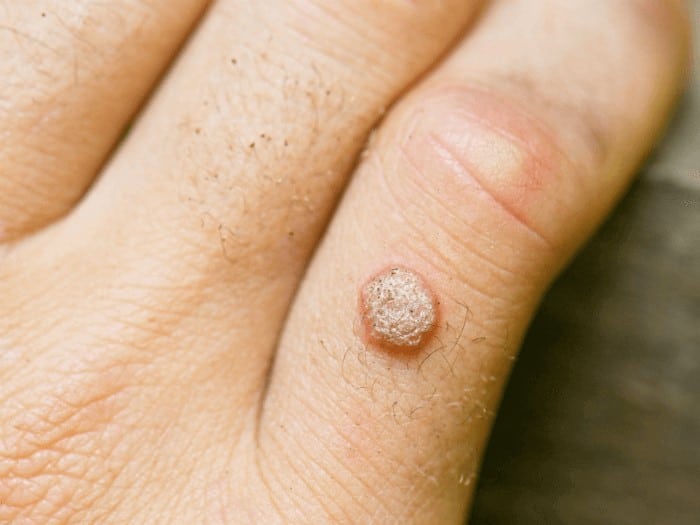Cozmoderm Clinic | Best Dermatology Clinic For Skin and Hair Care In Nagpur
Viral Warts
Home / Viral Warts

Viral Warts
- Common warts
- Foot (Plantar) warts
- Flat warts
Usually grow on the fingers, around the nails and on the backs of the hands. They are more common where skin has been broken, for example where fingernails are bitten or hangnails picked. These are often called “seed” warts because the blood vessels to the wart produce black dots that look like seeds.
Are usually on the soles (plantar area) of the feet and are called plantar warts. When plantar warts grow in clusters they are known as mosaic warts. Most plantar warts do not stick up above the surface like common warts because the pressure of walking flattens them and pushes them back into the skin. Like common warts, these warts may have black dots. Plantar warts have a bad reputation because they can be painful, feeling like a stone in the shoe.
Are smaller and smoother than other warts. They tend to grow in large numbers – 20 to 100 at any one time. They can occur anywhere, but in children they are most common on the face. In adults they are often found in the beard area in men and on the legs in women. Irritation from shaving probably accounts for this.
HOW DO YOU GET WARTS?
Warts are passed from person to person, sometimes indirectly. The time from the first contact to the time the warts have grown large enough to be seen is often several months. The risk of catching hand, foot, or flat warts from another person is small.
WHY ARE SOME PEOPLE MORE PRONE TO WARTS THAN OTHERS?
Some people get warts depending on how often they are exposed to the virus. Wart viruses occur more easily if the skin has been damaged in some way, which explains the high frequency of warts in children who bite their nails or pick at hangnails. Some people are just more likely to catch the wart virus than are others, just as some people catch colds very easily. Patients with a weakened immune system also are more prone to a wart virus infection.
DO I NEED TO TREAT MY WARTS?
In children, warts can disappear without treatment over a period of several months to years. However, warts that are bothersome, painful, or rapidly multiplying should be treated. Warts in adults often do not disappear as easily or as quickly as they do in children.
HOW CAN I TREAT MY WARTS?
Dermatologists are trained to use a variety of treatments, depending on the age of the patient and the type of wart.
- Salicylic Acid Lotion In young children can be treated at home by their parents on a daily basis by applying salicylic acid gel, solution or plaster. There is usually little discomfort but it can take many weeks of treatment to obtain favorable results. Treatment should be stopped at least temporarily if the wart becomes sore.
- Cryotherapy For adults and older children cryotherapy (freezing) is generally preferred. This treatment is not too painful and rarely results in scarring. However, repeat treatments at one to three week intervals are often necessary.
- Radiosurgery & Electrocautery Radiosurgery & Electrosurgery (burning) is another good alternative treatment. Laser treatment can also be used for resistant warts that have not responded to other therapies.
- Laser Pulsed dye laser CO2 laser
- Other treatments Another treatment is to inject each wart with an anti-cancer drug called bleomycin. The injections may be painful and can have other side effects.
- Warts may also be injected with interferon, a treatment to boost the immune reaction and cause rejection of the wart.
- Immunotherapy Immunotherapy, which attempts to use the body’s own rejection system is another method of treatment. Several methods of immunotherapy are being used. With one method the patient is made allergic to a certain chemical which is then painted on the wart. A mild allergic reaction occurs around the treated warts, and may result in the disappearance of the warts.
- General measures Avoid nail biting , deep cutting of nails .
DO WARTS DISAPPEAR ON THEIR OWN?
Many people, patients and doctors alike, believe folk remedies and hypnosis are effective. Since warts, especially in children, may disappear without treatment, it’s hard to know whether it was a folk remedy or just the passage of time that led to the cure. Since warts are generally harmless, there may be times when these treatments are appropriate. Medical treatments can always be used if necessary.
WHAT ABOUT THE PROBLEM OF RECURRENT WARTS?
Sometimes it seems as if new warts appear as fast as old ones go away. This may happen because the old warts have shed virus into the surrounding skin before they were treated. In reality new “baby” warts are growing up around the original “mother” warts. The best way to limit this is to treat new warts as quickly as they develop so they have little time to shed virus into nearby skin. A check by your dermatologist can help assure the treated wart has resolved completely.
IS THERE ANY RESEARCH GOING ON ABOUT WARTS?
Research is moving along very rapidly. There is great interest in new treatments, as well as the development of a vaccine against warts. We hope there will be a solution to the annoying problem of warts in the not too distant future.
